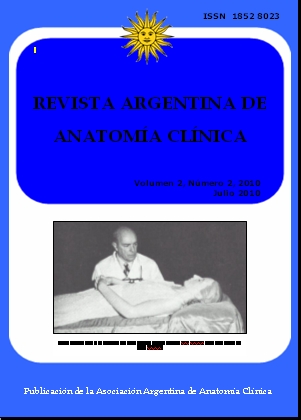USO DE IMÁGENES 3D DEL SISTEMA VENTRICULAR ENCEFALICO OBTENIDAS POR SISTEMA DE NEURONAVEGACIÓN EN LA ENSEÑANZA DE LA NEUROANATOMÍA EN EL PREGRADO. TRIDIMENSIONAL IMAGES OF THE VENTRICULAR SYSTEM OBTAINED IN A NEURONAVIGATOR SYSTEM AS A TOOL FOR NEUROAN
DOI:
https://doi.org/10.31051/1852.8023.v2.n2.13877Keywords:
Ventrículos cerebrales, Anatomía ventricular, Imagen 3D, cerebral ventricles, ventricular anatomy, 3D imagesAbstract
Introducción: El sistema ventricular encefálico es muy complejo, y es especialmente difícil de comprender para los estudiantes de pregrado. Clásicamente, la anatomía ventricular puede enseñarse usando encéfalos cadavéricos, imágenes de tomografía o resonancia magnética. Presentamos nuestra experiencia con el uso de imágenes tridimensionales obtenidas mediante un sistema de neuronavegación. Material y métodos: Se obtuvieron imágenes de resonancia magnética de 3 pacientes. Las imágenes fueron introducidas en un sistema de neuronavegación y se reconstruyó específicamente el sistema ventricular encefálico y algunas estructuras gangliobasales. Posteriormente se solicitó la opinión de 38 estudiantes de pregrado que cursaban la materia neuroanatomía, sobre la utilidad de las imágenes en el estudio del sistema ventricular.Discusión: todas las imágenes obtenidas fueron de buena calidad, el 100% de los estudiantes manifestó que las imágenes eran muy útiles o esenciales para comprender cabalmente la anatomía ventricular. Conclusiones: el uso de imágenes obtenidas por un sistema de neuronavegación son útiles en la enseñanza de la anatomía del sistema ventricular encefálico.
AIntroduction: Anatomy of cerebral ventricles is very complex. Classically, ventricular system anatomy has been taught employing cadaveric brains and CT or MRI images. We present 3D images of the ventricular system obtained by neuronavigation system and the results of its use in teaching anatomy of cerebral ventricles. Material and methods: Magnetic resonance images of three patients were obtained. These images were transferred to a neuronavigation system, and a 3D reconstruction of cerebral ventricles, were performed. Afterwards, 38 undergraduate students were required to give their opinion about how useful the images are in order to study the cerebral ventricles. Results: One hundred percent of the students agreed that the images were very useful or even essential to utterly comprehend the ventricular anatomy. Discussion: As other authors, we think that 3D images are very useful as a complement for teaching anatomy of cerebral ventricles. Conclusions: Employment of 3D images obtained in a computer system are useful for teaching the encephalic ventricular system anatomy, as a complementary tool.
References
Brenton H, Fernandez J, Bello F, Strutton O, Purkayastha S, Firht T, Darzi A (2007). Using multimedia and Web3D to enhance anatomy teaching. Comp Educ 49:32-53.
Del Maestro RF (1998). Historical vignette Leonardo da Vinci: the search for the soul. J Neurosurg 89:874–887.
Foulon P (2000). Historie des ventricules cèrèbraux. Neurochirurgie 46:142-146.
Frati P, Frati A, Salvati M, Marinozzi S, Frati R, Angeletti LR, Piccirilli M, Gaudio E, Delfini R (2006). Neuroanatomy and cadaver dissection in Italy: history, medicolegal issues, and neurosurgical perspectives. J Neurosurg 105:789-796.
Khalil MK, Lamar CH, Johnson TE (2008). Using computer-based interactive imagery strategies for designing instructional anatomy programs. Clin Anat 18:68-76
Martínez F, Armand Ugón G, Laza S, Sgarbi N (2006). Estudio de los ventrículos cerebrales mediante inyección de resinas poliéster. Rev Neurocirugía (La Plata) 8:18-21.
Martínez F, Decuadro G (2008). Galeno y el sistema ventricular. Parte I: los antecedentes. Neurocirugía (Astur) 19:58-65.
Martínez F, Soria Vargas VR, Sgarbi N, Laza S, Prinzo H (2004). Bases anatómicas de la hemisferotomía periinsular. Rev Med Uruguay 20:208-214.
Pereira-Sampaio MA, Favorito LA, Sampaio FJ (2004). Pig kidney: anatomical realtionships between arteries and the kidney collecting system. Applied study for urological research and surgical training. J Urol 172:2077-2081.
Sampaio FJ, Zanier JF, Aragao AH, Favorito LA (1992). Intrarenal access: 3-dimensional anatomical study. J Urol 148:1769-1773.
Timurkaynak E, Rhoton AL Jr., Barry M (1986). Microsurgical anatomy and operative approaches to the lateral ventricles. Neurosurgery 19:685-723.
Walker A E (1971). The cerebrospinal fluid from ancient times to the atomic age. Acta Neurol Latinoamer 17(Suppl 1):1-10.
Downloads
Published
Issue
Section
License
Authors retain copyright and grant the journal right of first publication with the work simultaneously licensed under a Creative Commons Attribution License that allows others to share the work with an acknowledgement of the work's authorship and initial publication in this journal. Use restricted to non commercial purposes.
Once the manuscript has been accepted for publications, authors will sign a Copyright Transfer Agreement to let the “Asociación Argentina de Anatomía Clínica” (Argentine Association of Clinical Anatomy) to edit, publish and disseminate the contribution.



